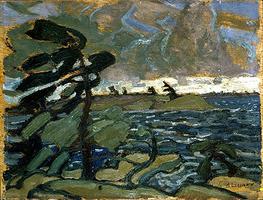Arthur Lismer, painter, educator (born 27 June 1885 in Sheffield, England; died 23 March 1969 in Montréal, QC). Arthur Lismer was one of the founders of the Group of Seven and a crucial figure in the development of arts education in
Education and Early Career
Arthur Lismer studied at Sheffield School of Art 1899–1906 and the Académie royale des beaux-arts,
In 1912 he returned to
Mature Work
Lismer's first Canadian paintings were heavily influenced by the 19th century British landscape painter John Constable, French Barbizon school artists like Jean-François Millet, and post-impressionist Belgian painters, but during the 1920s he developed a powerful expressionist style of his own, characterized by raw colour, heavy impasto, deliberately coarse brushwork and compressed simplified forms. In A September Gale, Georgian Bay (1921), for instance, there is a simple, swaying tree in the foreground rendered in earthy reds, the water a rhythmic pattern of whitecaps, the sky roiling with clouds. October on the North Shore, Lake Superior (1927), on the other hand, is a slightly elevated view of lake islands painted in thick earth tones, the water a subtly rippled blue-green, the sky a horizontal sweep of heavy — and also earth-toned — clouds.
Teaching
While an accomplished painter, Lismer devoted most of his time to art education. From 1927 to 1938 he was the educational supervisor at the Art Gallery of Toronto (now the Art Gallery of Ontario). In 1932, he undertook a nationwide lecture tour; invitations to conferences in Europe and
In 1938, he was visiting professor at Teachers College, Columbia

 Share on Facebook
Share on Facebook Share on X
Share on X Share by Email
Share by Email Share on Google Classroom
Share on Google Classroom






